Shortly after we met Rooster and Cola decided to book a short trip to Copenhagen, S C A R Y times.
As Rooster would soon find out, Cola planned everything, it was cold cold cold but we made the most of a very short trip

Copenhagen, Denmark’s charming capital, seamlessly blends history, culture, and modern living. Its picturesque canals, vibrant Nyhavn district, and world-renowned Tivoli Gardens offer a delightful experience. The city’s commitment to sustainability is evident in its extensive bike paths and eco-friendly initiatives. With its welcoming atmosphere, delicious cuisine, and stunning architecture, Copenhagen is a captivating destination for travelers seeking a unique European adventure.
Beyond its charming facade, Copenhagen boasts a rich cultural heritage. The Amalienborg Palace, home to the Danish royal family, and the iconic Christiansborg Palace, housing the Danish Parliament, offer glimpses into the country’s history. The city’s museums, including the National Gallery of Denmark and the Design Museum Denmark, showcase a diverse range of art and design.
Copenhagen’s culinary scene is equally impressive, offering a fusion of traditional Danish cuisine and international flavors. From cozy cafes serving warm pastries to Michelin-starred restaurants, the city caters to all tastes. The Torvehallerne market, a vibrant food hall, is a must-visit for foodies seeking fresh produce, artisanal cheeses, and delicious street food.
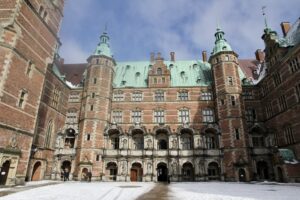 Frederiksborg Palace…
Frederiksborg Palace……in Hillerød is Scandinavia's largest Renaissance complex, built by King Christian IV in the early 17th century. Situated on three islets, its impressive architecture features towers and sandstone details. Since 1878, it houses the Danish Museum of National History, showcasing 500 years of Danish history through art and artifacts. The restored Great Hall and the Chapel, which survived a major fire, are highlights. The Chapel was historically used for royal coronations. Surrounding the palace are the Baroque Garden and the Romantic Garden, offering picturesque views and a glimpse into Denmark's royal heritage.
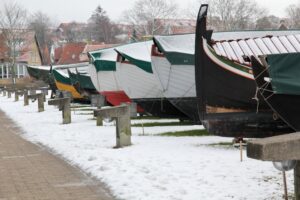 The Viking Ship Museum (Vikingeskibsmuseet) in Roskilde…
The Viking Ship Museum (Vikingeskibsmuseet) in Roskilde……is Denmark's national museum dedicated to ships from prehistoric and medieval times, particularly the Viking Age. Its main attraction is the Skuldelev ships, five original Viking vessels dating back to the 11th century, which were deliberately sunk in Roskilde Fjord to block enemy access to the city.
Excavated in 1962, these remarkably preserved ships represent different types, from warships to cargo vessels, offering unique insights into Viking shipbuilding, seafaring, trade, and warfare. The museum also features a boatyard where traditional Nordic boats and Viking ship replicas are built and maintained, allowing visitors to witness ancient boatbuilding techniques. Additionally, some reconstructed vessels offer sailing trips on the fjord, providing a hands-on Viking experience. The museum's exhibits explore the history and significance of these ships and the broader maritime culture of the Viking Age.
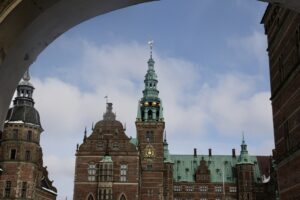 Kronborg Castle…
Kronborg Castle……is a magnificent Renaissance castle in Helsingør, Denmark, famed as the setting for Shakespeare's Hamlet. Originally built as a fortress in the 1420s to control the Øresund Strait and collect tolls, it was transformed in the late 16th century by King Frederik II into an opulent royal residence, a powerful symbol of Danish wealth and influence.
Its architecture showcases Netherlandish Renaissance style, with impressive sandstone facades, copper roofs, and ornate details. Despite suffering fires and Swedish occupation, it was largely reconstructed. Today, Kronborg Castle is a UNESCO World Heritage site, offering visitors a glimpse into royal life with its grand halls, tapestries, and the mythical statue of Holger the Dane in its casemates. It also hosts a Shakespare festival annually, celebrating its literary connection.
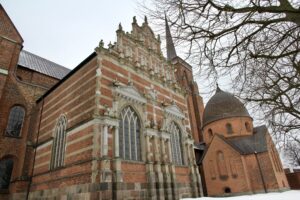 Roskilde Cathedral…
Roskilde Cathedral……a UNESCO World Heritage site, is a magnificent brick-built Gothic basilica dating back to the 12th and 13th centuries. It holds immense historical and architectural significance as Scandinavia's first Gothic cathedral constructed from brick, influencing the style across Northern Europe. For centuries, it has served as the royal burial church of Denmark, housing the tombs of nearly 40 kings and queens, showcasing the evolution of funerary art.
The cathedral's architecture reflects various periods, with Romanesque origins evolving into Gothic, and later additions in Renaissance, Baroque, and Neoclassical styles. Its impressive spires dominate the Roskilde skyline, and the interior boasts intricate details, including a grand altar and historical chapels. Roskilde Cathedral stands as a testament to Danish history, art, and the enduring connection between the monarchy and the church.
 The Little Mermaid statue…
The Little Mermaid statue……a beloved icon of Copenhagen, Denmark, sits gracefully on a rock at the Langelinie promenade. Unveiled in 1913, this bronze and granite sculpture was commissioned by Carl Jacobsen, the son of the Carlsberg brewery's founder, after he was captivated by Hans Christian Andersen's fairy tale of the same name. Sculpted by Edvard Eriksen, the statue depicts a mermaid wistfully gazing towards the shore, embodying the tale's themes of longing and sacrifice.
Standing at a modest 1.25 meters tall, the Little Mermaid has become a major tourist attraction, drawing countless visitors annually. Despite its relatively small size, it carries significant cultural weight, symbolizing Copenhagen and Danish identity. Over the years, it has endured vandalism and protests, yet it remains a resilient and enduring symbol of Andersen's timeless story and the city's charm.
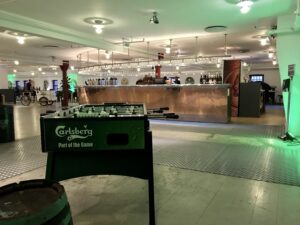 The Carlsberg Museum…
The Carlsberg Museum……nestled within the historic Carlsberg brewery site in Copenhagen, offers a fascinating journey through the history of one of the world's most renowned beer brands and the remarkable family behind it. Founded by J.C. Jacobsen in 1847, the museum chronicles the pioneering spirit and scientific innovation that propelled Carlsberg to global success.
Visitors can explore original brewing equipment, historical artifacts, and exhibits detailing the groundbreaking research conducted at the Carlsberg Laboratory, which revolutionized beer production. The museum also showcases the Jacobsen family's significant contributions to Danish art, culture, and philanthropy, including their patronage of the arts and the establishment of the Ny Carlsberg Glyptotek art museum. Through interactive displays and historical narratives, the Carlsberg Museum provides a rich understanding of industrial heritage, scientific advancement, and the enduring legacy of the Carlsberg name.
The travel journals of a middle age couple
All rights reserved
The travel journals of a middle age couple
All rights reserved